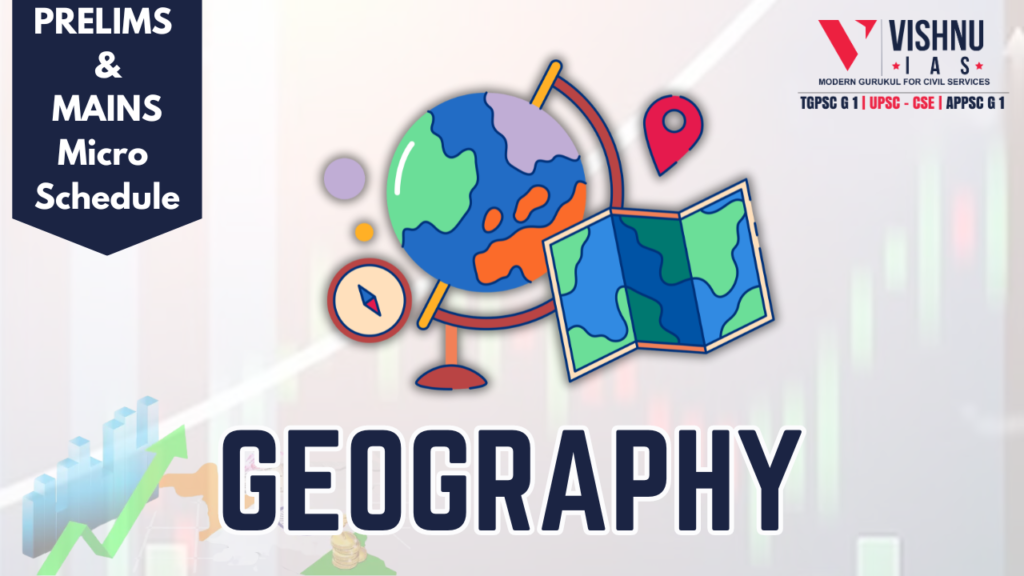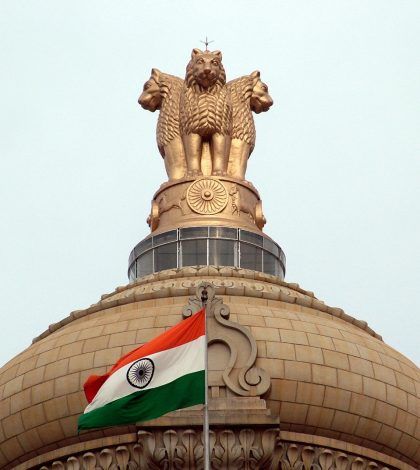UPSC Geography Syllabus ( Micro Topics)
The origin of the Earth
- Early Theories & Modern Theories – Big Bang Theory
- Star Formation & Formation of Planets
- Solar System
The Evolution of the Earth
- Layered Structure (5 layers)
- Evolution of Lithosphere,Atmosphere,Hydrosphere
- Geological History of the Earth
- Latitude and Longitude including important Parallels and Meridians
- Motions of the Earth – Rotation, Revolution and their effects
- Inclination of the Earth’s Axis and its effects
- Local and Standard Time and the International Date Line, Calendar
- Eclipses – Solar, Lunar
- Minerals – Major Elements of the Earth’s Crust Minerals – Feldspar , Quartz, Pyroxene Amphibole, Mica , Olivine
- Physical Characteristics–Crystal Form, Cleavage Fracture, Lusture, Color, Streak, Transparency, Structure, Hardness, Specific Gravity
- Metallic minerals – precious Ferrous, Non Ferrous Non-metallic Minerals – Sulphur, Phosphates, Cement
- Rocks (Aggregate of Minerals) , Petrology ,Rocks & landforms, Rocks & Soils
- 3 Family of Rocks Igneous ,Sedimentary, Metamorphic & Rock Cycle
- Waves: P, S, Body & Surface
- Shadow Zone
- Types ,Causes & Effects of Earthquake
- Frequency , Locating an Epicentre
- Distribution of Earthquake & Earthquake Observatories
Volcano
● Types – Shield ,Composite, Caldera,Flood Basalt,Mid Ocean Ridge
● Types of lava – Andesitic or Acidic lava ,Basic or Basaltic lava
● Intrusive volcanic Landforms – Batholiths Lacoliths Lapoliths Phacoliths Sills Dykes Extrusive Volcanic Landforms – Geysers and Hot springs
● Extinct, Dormant and Active volcanoes
● Distribution of Volcanoes
● Pacific Ring of Fire
● Mediterranean volcanism
● Other regions
● Effects of Volcanoes
Tsunami
● Mechanism of Tsunami waves
● Properties of Tsunami waves
● Effects of Tsunami
Geomorphic Processes
Earth’s Surface
- Exogenic Forces & Endogenic Forces- Gradation, Degradation & Agradation
- Geomorphic Process – Endogenic Process , Diastrophism , Orogenic, Epierogenic Earthquakes, Plate movements, Volcanism,
- Exogenic Forces
- Denudation Processes
- Weathering
- Mass movements
- Erosion: Transportation & Deposition
Distribution of Continents & Oceans
- Theories – Continental Drift Theory, Alfred Wegner 1912, Pangea, Panthalasa ,Laurasia, Gondwana land
- Evidence in support of Continental Drift Theory – Jigsaw Fit ,Rocks of same age across oceans Tillite,Placer Deposits,Distribution of Fossils
- Forces of Drifting- Pole Fleeing Force &Tidal Force
- Post Drift Studies – Convectional Current Theory & Mapping of the Ocean Floor
- Continents – plate Tectonics, Lithospheric Plates, Major Plate, Minor Plates
- Plate Boundaries- Divergent,Convergent &Transform
- Rates of Plate Movements, Force of plate movements
- Indian Plate – Movement from 71 million years ago till today
Landforms and their Evolution
- Causes of Geomorphic Processes
- Geomorphic Agents Erosional or Destructional Depositional or Constructional
- Agents and their Impacts – Wind, Running Water, Ground Water, Glaciers, Waves & Currents Winds – One of the Two dominant agents in Hot deserts
- Cause – Deflation Abrasion Impact
- Erosional landforms- Pediments and Pediplains Playas Deflation Hollows and Caves Mushroom , Table & Pedestal Rocks
- Depositional Landforms- Barchans, Seif ,Parabolic, Transverse & Longitudinal
- Running Water–Humid Regions – 2 Components – Overland Flow – Sheet ,Linear Flow – Strems
- Stages-Youth, Mature, Old
- Erosional Landforms – Valleys, Rills ,Gullies
- Valleys – V Shape, Gorge (Hard Rocks), Canyon (Sedimentary)
- Potholes & Plunge pools
- Incised or entrenched meanders & River Terraces – paired & unpaired
Depositional Landforms – Alluvial Fans, Delta, Floodplains, Natural Levees, Point Bars Meanders, Slip off bank, Under cut bank, Oxbow lake, Braided Channels
- Karst Topography – Permeable Rocks,Percolation, Bedding Plains , Limestone and Dolomite Regions Balkans, Adjacent to Adriatic regions
- Erosional Landforms Pools-Swallow Hole, Valley Sinks (Uvalas), Sinkholes, Collapse sinks (Dolines), Lapies, Ridges, Limestone Pavements
- Caves – Altering bed of Rocks (Shale sandstone quartzite), Caves and Tunnels
- Depositional landforms- Stalactites , Stalagmites, Pillar Columns ,
- Glaciers – Erosional Landforms – Cirque of Tarn Lakes Hors and Serrated Regions – Arete Glacial Valleys/ Troughs – Fiords
- Depositional Landforms- Glacial Tills,Moraines,Eskers,Outwash Planes, Drumlins
- Waves and Currents
- High Rocky Coasts & Low Sedimentary Coasts
- Erosional Landforms – Clifs, Terraces, Caves, Stacks
- Depositional Landforms- Beaches and Dunes , Bars Barriers Spits
- Weather over Earth Materials
- Factors – Geological,Climatic,Topograhic & Vegetative
- Major Processes – Chemical, Physical or Mechanical & Biological
- Forces Chemical Action – Solution, Carbonation, Hydration, Oxidation & Reduction Physical Forces- Gravitational, Expansion, Water Pressure Unloading & Expansion, Temperature changes and Expansion , Freezing, Thawing, & Frost Wedging, Salt Weathering Biological Weathering – Burrowing , Wedging, Plant Roots,
- Effects of Weathering Exfoliation (Flaking) – Exfoliation Domes, Tors
- Significance of Weathering- Soil Formation, Biomes and Biodiversity, Leaching/Enrichment Mass Movements – Activating causes, Forms of movement – Heave Flow Slide
- 3 major Groups – Slow Movement, Rapid Movements, Land Slides
- Landforms across the world: Rivers and lakes
- Mountain & Peaks- Fold Mountain, Block Mountain, Volcanic mountains
- Plateaus- Plateau Formation process , Plateau Types – Dissected plateau, Volcanic plateau
- Economic significance of plateau
- Major plateau of the world
- Composition of Atmosphere -Gases, Water Vapour,Dust Particles
- Structure- Exosphere, Thermosphere,Mesosphere ,Stratosphere,Troposphere ,Altitude vs Temperature
- Solar Radiation, Heat Balance, Temperature – Insolation ,Aphelion and Perihelion, Variability of Insolation at the surface of the Earth, Day Season Year ,Rotation on Axis, Angle of Inclination of sun rays, Length of the day,Transparency of Atmosphere, configuration of land in terms of its aspect
- Heat Balance – Heating and cooling of atmosphere ,Conduction ,Convection , Advection, Terrestrial Radiation
- Heat Budget of the Planet Earth
- Macro Budget – Albedo, Shortwave Radiation , Long wave Earth Radiation, Variation in the net Heat Budget at the Earth’s Surface
- Temperature : Factors controlling Temperature distribution & Inversion of Temperature Adiabatic Lapse Rate and Latent Heat of Condensation
- Atmospheric Circulation and Weather Systems– Atmospheric Pressure Belts and Wind Systems ,Atmospheric Pressure, Vertical variation of pressure, Horizontal distribution of pressure, World Distribution of Sea Level Pressure
- Factors affecting the velocity and direction of the wind.Pressure Gradient Force, Frictional Force, Coriolis Force, Pressure and Wind (Cyclonic & Anticyclone Circulation)
- Latitudinal Variation of Atmospheric Heating Emergence of Pressure Belts
- Migration of Belts Following apparent Path of Sun
- Distribution of continents & Oceans– Rotation of the Earth
- Geostrophic Wind, Jet Streams & Rossby Waves
- Major Jet Steams: Subtropical Jet Stream & Polar Jet Stream
- Air Mass and Air masses based on Source Regions
- Circulation- Simplified Global Circulation – Hadley Cell, Ferrell Cell. Seasonal Wind, Local Wind, Land and Sea Breezes, Mountain and Valley winds, AIR MASS – fronts, Extra Tropical Cyclone, Thunderstorms, Tornadoes, etc.
- Water Vapour, Precipitation, Humidity – Absolute and Relative. Saturation – Dew Point
- Evaporation and Condensation- Dew, Frost, Fog & Mist, etc
- Clouds Types – Cirrus Cumulus, Stratus Nimbus. High – Cirrus Cirrostratus Cirrocumulus Middle – Altostratus Altocumulus Low – Stratocumulus Nimbostratus Vertical Development – Cumulus and Cumulonimbus
- Precipitation Rainfall , Snowfall , Sleet , Hail Hailstones, etc
- Types of Rainfall Conventional, Orographic, Cyclonic World Distribution of Rainfall
- Important climatic phenomena and its effects- ENSO and LA Nina, IOD, Polar vortex, etc.
- Hot, Wet Equatorial Climate, Tropical Monsoon and Tropical Marine Climates Savanna or Sudan Climate, Hot Desert and Mid-Latitude Desert Climates,
- Warm Temperate Western Margin (Mediterranean)
- Climate Temperate Continental (Steppe)
- Climate Warm Temperate Eastern Margin (China Type)
- Climate Cool Temperate Western Margin (British Type)
- Climate Cool Temperate Continental (Siberian)
- Climate Cool Temperate Eastern Margin (Laurentian)
- Climate Arctic or Polar Climate
- Relief of the Ocean floor
- Divisions of the ocean floor– Continental Shelf, Continental Slope Deep sea plain, Oceanic deep and Trenches, etc
- Minor relief features– Mid oceanic ridges, Seamount, Submarine, canyons, Guy outs, Atoll, etc
- Temperature of the Ocean Water–Vertical, Spatial
- Factors affecting Temperature distribution–Latitude, Unequal distribution of land & Water, Prevailing wind, Ocean Currents
- Horizontal & Vertical Distribution – Thermo cline 3 layers
- Salinity of the Ocean Water–Factors affecting salinity
- Evaporation and precipitation ,Fresh water flow from rivers, Wind, Ocean currents, etc.
- Horizontal and vertical distribution of salinity
- Movements of ocean Water
- Factors influencing Movement- Temperature, Salinity, Density Sun moon winds
- Motion – Horizontal & Vertical Currents, Waves
- Relation between Gravitational Forces and Tides
- Tidal currents ,Types of Tides ,Importance of Tides
- Soil- Soil Characteristics
- Factors Responsible for Soil Formation
- Stages of Soil Formation
- Soil Forming Processes
- Soil Profiles and Horizons
- Soil Classification Soil Erosion and Conservation
- Natural vegetations- Types of forest and their distribution,Classification of forests
- Wild life-Flora, Fauna- Types, Distribution, Status, etc.
- Mineral resources
- Mineral resources- Distribution of minerals
- Important mining regions
- Distribution, production and international trade of Metallic and non-metallic minerals.
- Conservation
- Energy resources
- Production of conventional energy
- Reserves and sources of energy
- Coal – Nature and origin of coal.
- Constituents and kinds of coal.
- Coal fields and coal production.
- By products of coal.
- Conservation of Coal Petroleum.
- Petroleum -Nature and properties of petroleum Origin and recovery, Exploration. Petroleum refining, Petroleum reserves
- Natural gas Reserves and Production
- Hydro-electricity– Distribution of potential hydro-power
- Hydro-electric power generation.
- Atomic (nuclear) energy –World distribution of uranium. Production of uranium, Thorium.
- Production of atomic (nuclear) energy, Important nuclear reactor sites
- Non-conventional sources of energy-Solar energy, Wind energy, Geothermal power, Tidal energy Wave energy, Biomass energy, etc
- Iron and Steel Industry
- Textile Industry
- Chemical Industry
- Agro-industries
- Pulp and paper industry
- Cement industry
- Petroleum refining industry
Essential conditions, Location, development and distribution. Factors of production.
- Land-use
- Land capability
- classification Causes of Land Degradation.
- Impact of Land Degradation.
- Steps taken by Government.
- Sustainable Land Management
- Population distribution
- Factors of population distribution— Physical factors, Socio-cultural factors and Demographic factors, etc.
- World population distribution.
- Population density Determinants of population growth
- Characteristics of population – Age composition, Population pyramids, Sex composition Literacy, etc
- The Northern and North-eastern Mountains
- The Northern Plain
- The Peninsular Plateau
- The Indian Desert
- The Coastal Plains
- The Islands
- Himalayan drainage system -Source or Origin,Tributaries
- Peninsular drainage system- Distributaries, Dams and irrigation, canals Hydroelectric projects
- Smaller Rivers Flowing Towards the West– Water ways Flows through state, national parks, WLS, etc
- Small Rivers Flowing towards the East– Border sharing Important Drainage Patterns
- Factors determining the climate of India
- Factors related to Location and Relief
- Factors Related to Air Pressure and Wind
- Mechanism of Weather in the Winter Season
- Mechanism of Weather in the Summer Season
- Mechanism of South west monsoon
- Mechanism of retreating monsoon
- The cold weather seasons
- The hot weather seasons
- The southwest monsoon seasons
- The retreating monsoon seasons
- Famous Local Storms of Hot Weather Season
- Characteristics of Monsoonal Rainfall
- Traditional Indian seasons
- Distribution of Rainfall
- Climatic Regions of India
- Tropical Evergreen and Semi Evergreen forests
- Tropical Deciduous forests
- Tropical Thorn forests
- Montane forests
- Littoral and Swamp forests.
- Types of Farming
- Cropping Seasons in India
- Cropping pattern Agro climate of India
- Conditions required for crop cultivation
- Irrigation system


